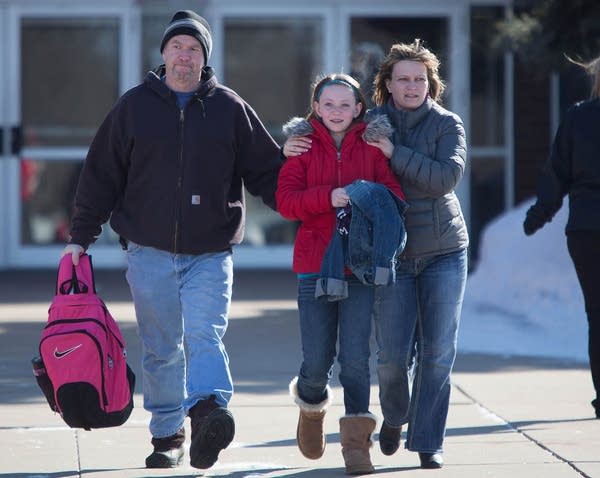New Prague officials said they were prepared for the worst
Go Deeper.
Create an account or log in to save stories.
Like this?
Thanks for liking this story! We have added it to a list of your favorite stories.

A middle-school student faces a juvenile detention hearing after police claim he phoned 911 and falsely reported a shooting at New Prague Middle School.
Wednesday's incident was just a hoax, but it offers a glimpse at how Minnesota schools are prepared to react to dangerous situations, something that's been heightened since the school shootings in Connecticut four months ago.
The incident began with a 7:55 a.m. phone call to 911, during which the caller claimed there had been a shooting at New Prague Middle School.
Officers from several area communities headed to the scene, and the district's six buildings went into the highest level of lockdown, a "code red."
Turn Up Your Support
MPR News helps you turn down the noise and build shared understanding. Turn up your support for this public resource and keep trusted journalism accessible to all.
It all happened very quickly, Superintendent Larry Kauzlarich said.
"I went out into the halls. I watched how quickly that code red came," Kauzlarich said. "Our staff and students reacted. And they closed those doors, turned off the lights and it was dead silence in there."
Eighth-grader Miles Mishke, 14, heard the Code Red announcement over the school's PA system.

"We were going to gym and then heard about it over the intercom, so we went to our weight room and sat there for two hours," Mishke said.
From a student's point of view, everything went smoothly, Mishke said.
"Pretty good. Everybody was quiet and kept calm."
Eighth-grader Rosie Friedges said she and a few other students were cleaning up after an Honor Society breakfast when they heard the code red announcement. They hid in a nearby classroom, as they have been taught to do.
"Yeah, we've practiced it many times," Friedges said.
All Minnesota schools must have a safety plan in place, and are required to run through drills at least five times a year.
As police began their investigation in two middle school buildings, word of the lockdown went out to parents from students via their cell phones. It also spread to social media sites and news websites before school officials were able to alert parents.

Notification of the lockdown was not posted on the New Prague Middle School website, and did not make it onto the district's website until well after the incident occurred.
Parents received automated calls from the district, but some say that happened after receiving the news from other sources.
Rich Novak arrived at the school just after 9 a.m. hoping to pick up his 8th grade daughter.
"The notification from the school didn't come out until right before 9 o'clock," Novak said. "I have a brother and a sister-in-law on vacation down in Florida on vacation and they contacted me before the school even notified us."
Kauzlarich said the district's notification system is fairly responsive, but it can't beat teens with mobile phones.
"Children have cell phones. They're calling mom and dad right away," Kauzlarich said. "We do know they get out there real fast."
A quick investigation by police discovered the hoax and a 12-year old boy was taken into custody. Law enforcement officials say he used a disabled cell phone that was able only to dial 911.
Just after 10 a.m., two hours after the code red alert went into effect, classes were dismissed for the rest of the day and parents were allowed to take students home.
New Prague Police Chief Mike Vosejpka told reporters during a news conference that the school handled the lockdown well.
"It went very smooth. They did a very good job," Vosejpka said. "And all the students are safe. No one was injured in this incident whatsoever."
Wednesday's incident comes as Gov. Mark Dayton is proposing to reopen a school safety center within the Department of Public Safety and open a new school climate center at the Department of Education.
The department's chief of staff, Charlene Briner, said the two centers would provide schools with resources and training on how to deal with emergencies.
"Working in tandem to create a proactive approach so we're not dealing with these sort of situations real or otherwise," Briner said.
Briner said schools walk a fine line in preparing for dangerous situations. They want students to know how to best react, but at the same time school officials don't want to worry parents and students about the safety of their schools.






